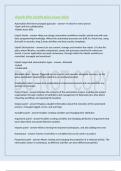Exam (elaborations)
UIPath RPA Certification
- Course
- Institution
Solution Architect - answer-Is in charge of defining the Architecture of the RPA solution. Translates the requirements captured by the functional analysts, creating the architecture and design artifacts. They lead, advises, and are responsible for the developers' team delivery. Business Analyst ...
[Show more]



